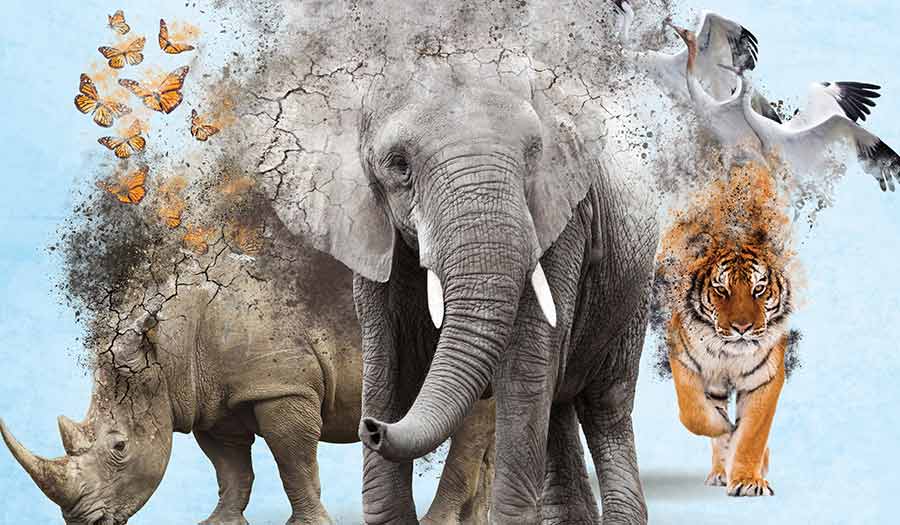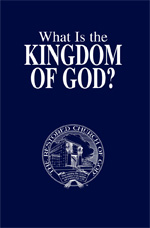 The Real Truth/Jody E. Lydick
The Real Truth/Jody E. Lydick
Article
Is there anything the global community can do to stem the tide?
Learn the why behind the headlines.
Subscribe to the Real Truth for FREE news and analysis.
Subscribe NowNature is in crisis, and it is only getting worse. Species are vanishing at a rate unseen in human history, with more than 1 million species now on the brink.
Experts say that people are driving this extinction crisis through activities that take over animal habitats, pollute nature and fundamentally alter ecosystems.
When many hear such statistics, the discussion can quickly turn political: What should the government do to stem the tide of extinction? Does anything need to be done at all?
Yet these debates overlook the most important question: What does God think of this trend?
His first command to mankind in the Garden of Eden was “to dress it and to keep it” (Gen. 2:15). This really applies to the entire planet, and still applies now. The word translated “keep” in this verse means to guard, retain, protect and save. Taking care of the Earth and its animal inhabitants is man’s God-given responsibility.
Mankind is utterly failing to do this today.
According to many scientists, the mass extinction event that is now underway is only worsening. A mass extinction event happens when the extinction rate jumps so high that more than 75 percent of the world’s species go extinct within a relatively short time.
When an animal species is lost, an entire set of characteristics disappears along with it—genes, behaviors and activities. Whatever role that species played within an ecosystem is lost too—whether pollinating certain plants, churning nutrients in the soil, fertilizing forests, keeping other animal populations in check, among other things. If that function is crucial to the health of an ecosystem, the animals’ disappearance could cause a landscape to transform. Lose too many species, and the results could be catastrophic, leading an entire system to collapse.
“Despite our best efforts, the extinction rate is still estimated to be 1,000 times higher than before humans entered the stage,” said Paula Ehrlich, president and CEO of the E.O. Wilson Biodiversity Foundation. She estimates that half of the planet’s remaining biodiversity will be gone by the end of the century.
Extreme weather, habitat loss, pollution and development have hammered the world’s biodiversity, with the United Nations warning in 2019 that a million plant and animal species face extinction within decades—a rate of loss 1,000 times greater than expected. Humans use about 50,000 wild species routinely, and 1 out of 5 people of the world’s over 8 billion population depend on them for food and income, according to the report.
But deep down, human beings know they should protect nature. Governments the world over agree on this much—but they do not agree on what to do about it.
In December 2022, the United Nations Biodiversity Conference (COP15) reached a historic deal to try to save Earth’s biodiversity and protect its lands and oceans. The most significant part of the agreement was a commitment to protect 30 percent of land and water considered essential for biodiversity by 2030, known as 30 by 30. Currently, 17 percent of terrestrial and 10 percent of marine areas are protected.
The Wildlife Conservation Society and other environmental groups are concerned that COP15’s deal only puts off the goal of preventing the extinction of species, preserving the integrity of ecosystems and maintaining the genetic diversity within populations until 2030. They fear the UN timeline is not ambitious enough.
Counting the Failures
Over the last five centuries, hundreds of unique animals across the world have vanished, such as the flightless dodo bird killed off from the island of Mauritius in the 1600s.
In many cases of species loss, humans were to blame, due to activities like fishing or hunting. This was the case with South Africa’s zebra subspecies quagga, which was hunted to its end in the late 19th century. In modern times, this would include any activity that pollutes, disrupts or takes over wild habitats.
For historical extinctions, it was not until long after the fact that scientists realized a species was gone forever. In contrast, people can now often watch animals go extinct in real-time.
Before a species disappears entirely, it may already be considered “functionally extinct”—with not enough specimens left to ensure the species ultimately survives. The last known specimens are known as “endlings.” When this happens, human beings can interact with these animals but are powerless to stop them from disappearing forever.
Some species we know today could soon be reduced to endlings. The world’s smallest porpoise, Mexico’s critically endangered vaquita, is down to just 18 known individuals in the wild, as fishing nets have ravaged its population.
The northern white rhino subspecies, the second-largest land mammal after elephants, now has no hope of recovery after the last male died in 2018. Only a female and her daughter are left.
This rhino is not just a part of the world, it is a world unto itself—a miniature ecosystem. It mows fields through grazing, fertilizes lands where it walks, allows insects to land on its skin, and then allows birds to feed off those insects. Losing this species of rhino affects much more than the rhino itself.
The current estimates for extinction are alarming, but the reality is likely even worse. Counting official species extinctions does not give the full picture, because scientists are incredibly conservative when declaring a species is gone. They will often label an animal as “critically endangered, possibly extinct,” even if just one of its kind is known to exist.
Endlings are the exception. Most extinct species have simply faded away in the wild without anyone noticing.
Scientists count 881 animal species as having gone extinct since around 1500, dating back to the first records held by the International Union for Conservation of Nature, the global scientific authority on the status of nature and wildlife. And realize that this only represents cases resolved with a high degree of certainty.
If we include animal species scientists suspect might be extinct, that number shoots up to 1,473. Yet why is the bar so high for declaring a species officially extinct?
“It’s hard to prove the negative, to prove you can’t find it,” said Sean O’Brien, an ecologist who heads the NatureServe nonprofit working to establish definitive data on North American species. “And it’s emotional. A botanist doesn’t want to declare it extinct because it feels like a failure.”
Among terrestrial vertebrates—land animals with a backbone—322 species have been declared extinct since 1500. Add in the number of possibly extinct species, and the tally comes to 573.
For moisture-loving amphibians, vulnerable to both pollution and drought, things look particularly bleak, with the extinction rate escalating over the last few decades. Only 37 species have been declared extinct with a high degree of certainty since 1500. But scientists suspect more than 100 others have disappeared over the last 30 to 40 years, according to a 2015 study in the journal Science Advances.
There are many notable species among those that have vanished since 1500. The dodo, referenced earlier, was last seen in 1662, within 65 years of its first being recorded. The Pinta Island tortoise was last seen in the wild in 1972.
Some vanishings have inspired public outcry, such as the 2016 extinction declaration for the tiny Christmas Island pipistrelle bat species, last seen in 2009. It was Australia’s first recorded mammal extinction in 50 years.
Losing hundreds of species over 500 years may not feel significant when millions of species are still living on the planet. But the speed at which species now vanish is unprecedented in the last 10 million years.
Why It Matters
There are also a vast number of animal species that mankind has yet to discover. Scientists have identified some 1.2 million species worldwide but estimate there are actually more than 8.7 million in existence. That leaves roughly 7.5 million species that we think are out there but know nothing about—including whether they are in trouble.
“Somewhere in the core of our humanity, we recognize these creatures, we’re touched by their story, and we feel compassion—and maybe also a moral compulsion—to help,” Dr. Ehrlich said.
The deep-seated desire to protect nature goes well beyond moral compulsion. It is built into humanity.
After creating everything seen in the world today, God said this to the first human beings: “I have given you every herb bearing seed, which is upon the face of all the earth, and every tree, in the which is the fruit of a tree yielding seed; to you it shall be for meat. And to every beast of the earth, and to every fowl of the air, and to everything that creeps upon the earth, wherein there is life, I have given every green herb for meat: and it was so” (Gen. 1:29-30).
God has given man everything and placed it under his dominion. Yet realize that God made it all. This fact alone should reframe any catastrophic effects human actions have on the environment. In Genesis 1, He called everything He made “good.”
People should treat nature and the animal species within it with deep respect because God made it all.
Yet protecting nature’s awesome intricacies and variety goes far beyond realizing that the God of the universe entrusted it to humanity. It points back to why mankind exists in the first place.
This was not lost on King David. Thousands of years ago, looking out at the natural world prompted him to be introspective. Notice Psalm 8:3: “When I consider Your heavens, the work of Your fingers, the moon and the stars, which You have ordained; what is man, that You are mindful of him?”
He summarized the verses from Genesis 1: “You made him to have dominion over the works of Your hands; You have put all things under his feet: all sheep and oxen, yes, and the beasts of the field; the fowl of the air, and the fish of the sea, and whatsoever passes through the paths of the seas” (Psa. 8:6-8).
Like the animals, human beings were created by God. Before we can stem the extinction crisis, mankind needs to first answer the biggest question: Why are we on this Earth?
If everyone truly sought an answer to that question from God’s Word, and then followed its commands, Creation would be preserved as God intended.
With so many differing and conflicting views and perspectives the world over, that is impossible today. But God has an incredible purpose for creating human beings and putting them on the Earth. And there is a time coming soon when, finally, man can fulfill his directive to dress and keep God’s Creation.
Isaiah 11:9 speaks of this time: “They shall not hurt nor destroy in all My holy mountain: for the earth shall be full of the knowledge of the Lord, as the waters cover the sea.”
To understand how God will bring this verse to pass, read What Is the Kingdom of God?
This article contains information from Reuters and The Associated Press.



